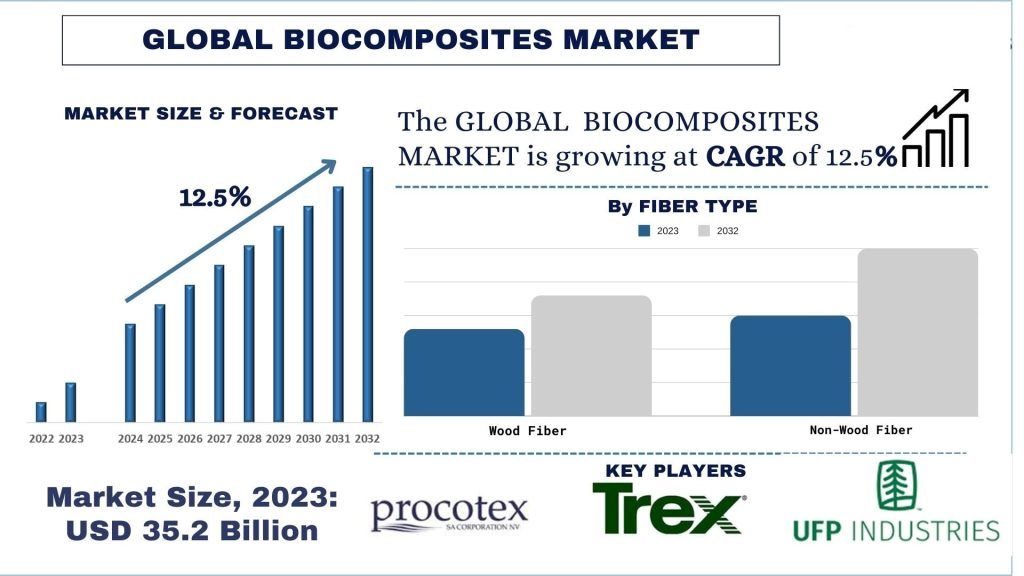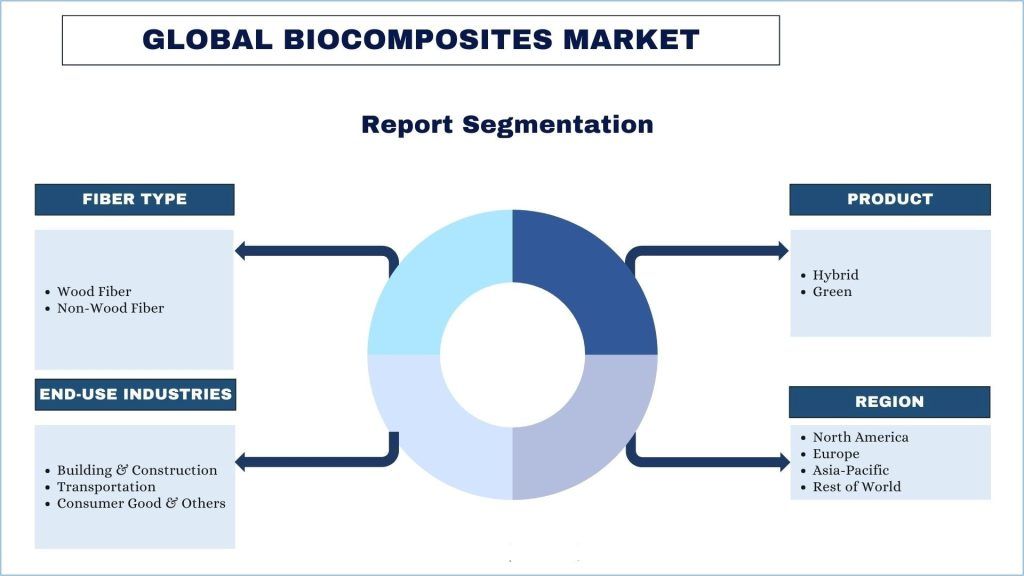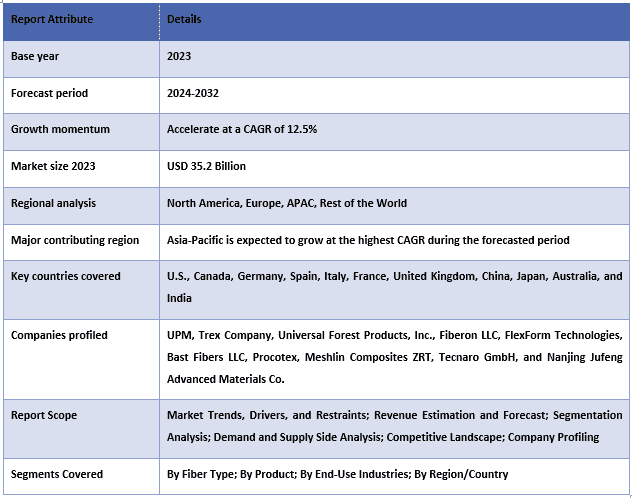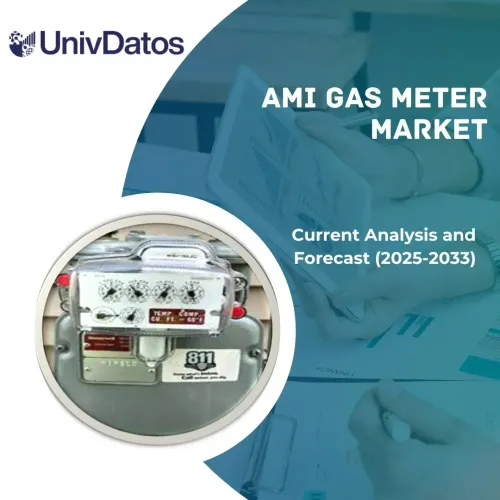- Home
- About Us
- Industry
- Services
- Reading
- Contact Us
Biocomposites Market: Current Analysis and Forecast (2024-2032)
Emphasis on Fiber Type (Wood and Non-Wood Fiber); Product (Hybrid and Green); End-Use Industries (Building & Construction, Transportation, and Consumer Goods & Other); Region/Country.

Biocomposites Market Size & Forecast
The Biocomposites Market was valued at USD 35.2 Billion and is expected to grow at a strong CAGR of around 12.5% during the forecast period (2024-2032) owing to rising investment in sustainable products.
Biocomposites Market Analysis
Biocomposites are composite materials made from natural fibers and a polymer matrix, which can be derived from renewable sources or traditional plastics. The natural fibers, such as wood, flax, hemp, and jute, provide reinforcement, while the polymer matrix, which can be either biodegradable (like polylactic acid, PLA) or synthetic (like polypropylene, PP), binds the fibers together and facilitates load transfer. They offer an eco-friendly alternative to conventional composites and plastics by utilizing sustainable resources and reducing environmental impact.
Biocomposites, being primarily made from natural and renewable materials, have a significantly lower carbon footprint compared to traditional materials like plastics and metals. Their production typically involves less energy-intensive processes and results in lower greenhouse gas emissions. Biocomposites often have lower levels of toxicity and are safer for both consumers and manufacturers. Unlike many traditional composites, they do not release harmful emissions during production or disposal, contributing to a healthier environment. Asia-Pacific is rapidly emerging as a significant market, driven by expanding manufacturing sectors, particularly in China and India, and increasing environmental concerns.
While the initial costs of biocomposite materials can be higher than conventional materials due to the nascent stage of technology and smaller scale of production, advancements in processing and economies of scale have the potential to reduce these costs over time. The future of the biocomposite market looks promising with continued technological advancements and growing environmental awareness. As production processes become more efficient and economies of scale are achieved, biocomposites are expected to become more cost-effective and widely used, paving the way for a sustainable future in material science.
Biocomposites Market Trends
This section discusses the key market trends that are influencing the various segments of the Biocomposites as identified by our team of research experts.
Technological Advancements:
Innovations in material science have significantly improved the properties of biocomposites, such as strength, durability, and resistance to environmental factors, making them viable alternatives to traditional materials like plastics and metals. For instance: Nano-enhanced Biocomposites: This technology involves incorporating nanoparticles into biocomposite materials to improve their mechanical, thermal, and barrier properties. Nanoparticles such as nano-clay, carbon nanotubes, or graphene oxide are used due to their exceptional strength and stiffness. These nanoparticles, when added even in small amounts, can significantly enhance the structural integrity of biocomposites, making them comparable or even superior to traditional synthetic composites in certain applications.

APAC is Expected to Grow with Significant CAGR During Forecast Period
APAC registered the highest market share in the Biocomposites market and is expected to witness an influential CAGR in the forecasted period. The Asia-Pacific (APAC) biocomposite market is characterized by rapid growth and diverse applications, driven by the region’s vast agricultural resources and expanding industrial base. Countries like China, India, Japan, and South Korea are leading in the production and utilization of biocomposites, leveraging them primarily in the automotive, construction, and packaging industries. The market benefits from a combination of abundant natural fiber resources, such as bamboo, jute, and sisal, and a strong manufacturing sector. Additionally, increasing environmental awareness and governmental policies aimed at reducing plastic use and promoting sustainable materials significantly fuel market growth. For instance – China’s announcement in February 2024 of a new five-year plan focusing on biocomposite development as part of its broader initiative to decrease pollution and increase the use of renewable resources in industrial applications.

Biocomposites Industry Overview
The Biocomposites market is competitive and fragmented, with the presence of several global and international market players. The key players are adopting different growth strategies to enhance their market presence, such as partnerships, agreements, collaborations, new product launches, geographical expansions, and mergers and acquisitions. Some of the major players operating in the market are UPM, Trex Company, Universal Forest Products, Inc., Fiberon LLC, FlexForm Technologies, Bast Fibers LLC, Procotex, Meshlin Composites ZRT, Tecnaro GmbH, and Nanjing Jufeng Advanced Materials Co.
Biocomposites Market News
In 2023, BASF SE introduced Battery Materials Innovations, BASF has introduced new cathode active materials (CAM) for electric vehicle batteries. These materials are designed to reduce the environmental footprint of battery production and improve performance. Its used for electric vehicles, Focus on reducing the use of raw materials like nickel and cobalt and increasing the use of recycled metals.
In 2023, BASF SE introduced NovaFlex SharkSkin, This innovative surface film mimics sharkskin to reduce aerodynamic drag on aircraft, enhancing fuel efficiency. It’s being applied to Lufthansa Cargo’s 777F fleet and SWISS International Air Lines’ Boeing 777-300ER passenger planes. It Reduces fuel consumption and CO₂ emissions significantly.
Biocomposites Market Report Coverage

Reasons to buy this report:
- The study includes market sizing and forecasting analysis validated by authenticated key industry experts.
- The report presents a quick review of overall industry performance at one glance.
- The report covers an in-depth analysis of prominent industry peers with a primary focus on key business financials, product portfolios, expansion strategies, and recent developments.
- Detailed examination of drivers, restraints, key trends, and opportunities prevailing in the industry.
- The study comprehensively covers the market across different segments.
- Deep dive regional level analysis of the industry.
Customization Options:
The global Biocomposites can further be customized as per the requirement or any other market segment. Besides this, UMI understands that you may have your own business needs, hence feel free to connect with us to get a report that completely suits your requirements.
Table of Content
Research Methodology for the Biocomposites Analysis (2024-2032)
Analyzing the historical market, estimating the current market, and forecasting the future market of the global Biocomposites were the three major steps undertaken to create and explore the adoption of Biocomposites in major regions globally. Exhaustive secondary research was conducted to collect the historical market numbers and estimate the current market size. Secondly, numerous findings and assumptions were taken into consideration to validate these insights. Moreover, exhaustive primary interviews were also conducted with industry experts across the value chain of the global Biocomposites. Post assumption and validation of market numbers through primary interviews, we employed a top-down/bottom-up approach to forecasting the complete market size. Thereafter, market breakdown and data triangulation methods were adopted to estimate and analyze the market size of segments and sub-segments of the industry. Detailed methodology is explained below:
Analysis of Historical Market Size
Step 1: In-Depth Study of Secondary Sources:
A detailed secondary study was conducted to obtain the historical market size of the Biocomposites through company internal sources such as annual reports & financial statements, performance presentations, press releases, etc., and external sources including journals, news & articles, government publications, competitor publications, sector reports, third-party database, and other credible publications.
Step 2: Market Segmentation:
After obtaining the historical market size of Biocomposites, we conducted a detailed secondary analysis to gather historical market insights and share for different segments and sub-segments for major regions. Major segments are included in the report as Fiber Type, Product and End-Use Industries. Further country-level analyses were conducted to evaluate the overall adoption of testing models in that region.
Step 3: Factor Analysis:
After acquiring the historical market size of different segments and sub-segments, we conducted a detailed factor analysis to estimate the current market size of the Biocomposites. Further, we conducted factor analysis using dependent and independent variables such as Fiber Type, Product and End-Use Industries of the Biocomposites. A thorough analysis was conducted of demand and supply-side scenarios considering top partnerships, mergers and acquisitions, business expansion, and product launches in the Biocomposites sector across the globe.
Current Market Size Estimate & Forecast
Current Market Sizing: Based on actionable insights from the above 3 steps, we arrived at the current market size, key players in the global Biocomposites, and market shares of the segments. All the required percentage shares split, and market breakdowns were determined using the above-mentioned secondary approach and were verified through primary interviews.
Estimation & Forecasting: For market estimation and forecast, weights were assigned to different factors including drivers & trends, restraints, and opportunities available for the stakeholders. After analyzing these factors, relevant forecasting techniques i.e., the top-down/bottom-up approach were applied to arrive at the market forecast for 2032 for different segments and sub-segments across the major markets globally. The research methodology adopted to estimate the market size encompasses:
- The industry’s market size, in terms of revenue (USD) and the adoption rate of the Biocomposites across the major markets domestically
- All percentage shares, splits, and breakdowns of market segments and sub-segments
- Key players in the global Biocomposites in terms of products offered. Also, the growth strategies adopted by these players to compete in the fast-growing market
Market Size and Share Validation
Primary Research: In-depth interviews were conducted with the Key Opinion Leaders (KOLs) including Top Level Executives (CXO/VPs, Sales Head, Marketing Head, Operational Head, Regional Head, Country Head, etc.) across major regions. Primary research findings were then summarized, and statistical analysis was performed to prove the stated hypothesis. Inputs from primary research were consolidated with secondary findings, hence turning information into actionable insights.
Split of Primary Participants in Different Regions

Market Engineering
The data triangulation technique was employed to complete the overall market estimation and to arrive at precise statistical numbers for each segment and sub-segment of the global Biocomposites. Data was split into several segments & sub-segments post studying various parameters and trends in the areas of Fiber Type, Product and End-Use Industries in the global Biocomposites.
The main objective of the Global Biocomposites Study
The current & future market trends of the global Biocomposites were pinpointed in the study. Investors can gain strategic insights to base their discretion for investments on the qualitative and quantitative analysis performed in the study. Current and future market trends determined the overall attractiveness of the market at a regional level, providing a platform for the industrial participant to exploit the untapped market to benefit from a first-mover advantage. Other quantitative goals of the studies include:
- Analyze the current and forecast market size of the Biocomposites in terms of value (USD). Also, analyze the current and forecast market size of different segments and sub-segments
- Segments in the study include areas of Fiber Type, Product and End-Use Industries
- Define and analysis of the regulatory framework for the Biocomposites industry
- Analyze the value chain involved with the presence of various intermediaries, along with analyzing customer and competitor behaviors of the industry
- Analyze the current and forecast market size of the Biocomposites for the major region
- Major countries of regions studied in the report include Asia Pacific, Europe, North America, and the Rest of the World
- Company profiles of the Biocomposites and the growth strategies adopted by the market players to sustain in the fast-growing market
- Deep dive regional level analysis of the industry
Frequently Asked Questions FAQs
Q1: What is the current market size and growth potential of the Biocomposites market?
Q2: What are the driving factors for the growth of the Biocomposites?
Q3: Which segment has the largest share of the Biocomposites by Fiber Type?
Q4: What are the emerging technologies and trends in the Biocomposites?
Q5: Which region will dominate the Biocomposites?
Related Reports
Customers who bought this item also bought










